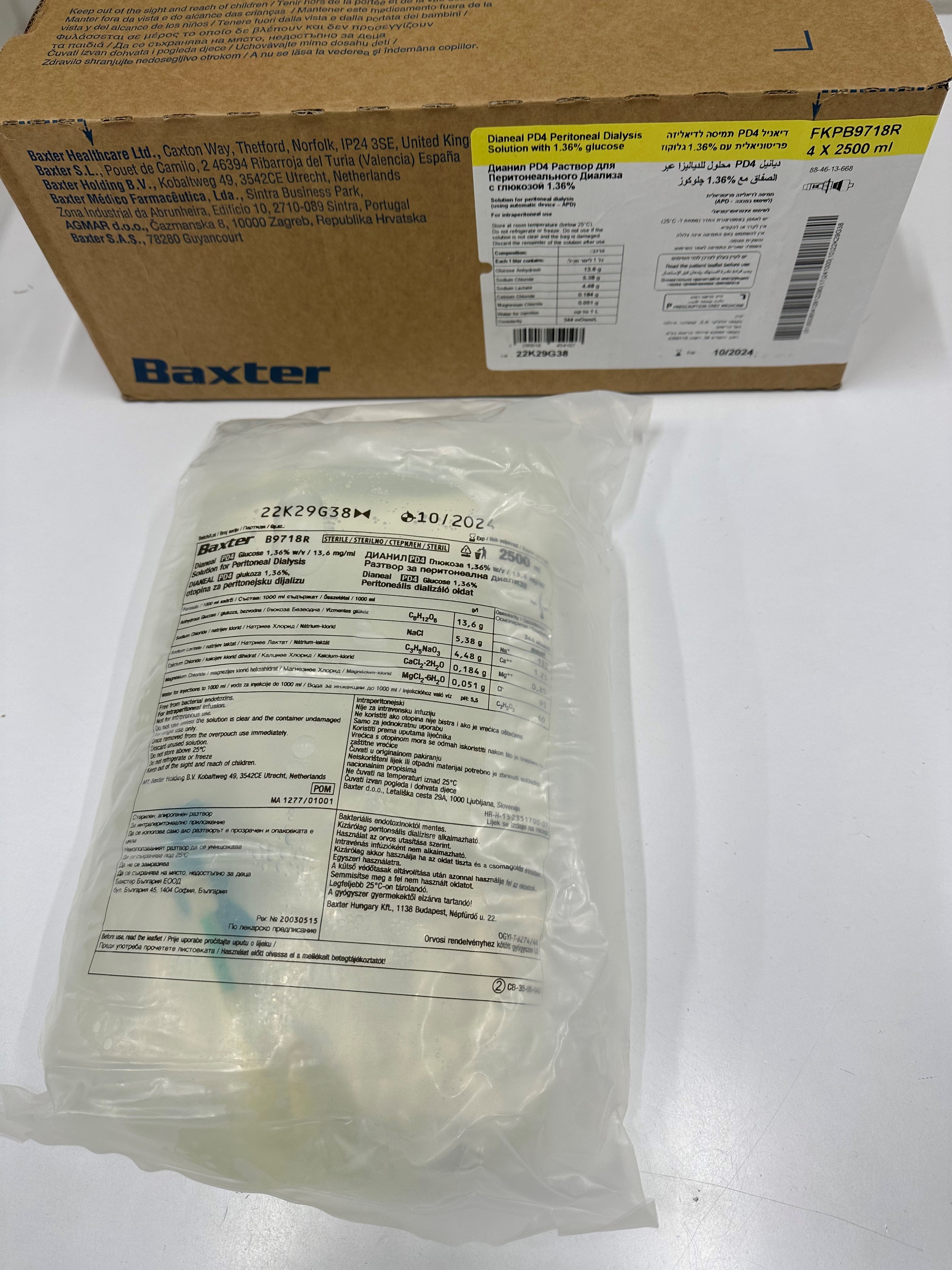Quest for the right Drug

דיאניל PD-4 תמיסה לדיאליזה פריטוניאלית עם % 1.36 גלוקוז DIANEAL PD-4 PERITONEAL SOLUTION WITH 1.36 % GLUCOSE (CALCIUM CHLORIDE, GLUCOSE, GLUCOSE AS MONOHYDRATE, LACTIC ACID AS SODIUM, MAGNESIUM CHLORIDE, SODIUM CHLORIDE)
תרופה במרשם
תרופה בסל
נרקוטיקה
ציטוטוקסיקה
צורת מתן:
דיאליזה לחלל הבטן : PERITONEAL DIALYSIS
צורת מינון:
תמיסה לדיאליזה פריטוניאלית : SOLUTION FOR PERITONEAL DIALYSIS
עלון לרופא
מינוניםPosology התוויות
Indications תופעות לוואי
Adverse reactions התוויות נגד
Contraindications אינטראקציות
Interactions מינון יתר
Overdose הריון/הנקה
Pregnancy & Lactation אוכלוסיות מיוחדות
Special populations תכונות פרמקולוגיות
Pharmacological properties מידע רוקחי
Pharmaceutical particulars אזהרת שימוש
Special Warning עלון לרופא
Physicians Leaflet
Special Warning : אזהרת שימוש
4.4 Special warnings and precautions for use • Peritoneal dialysis should be done with caution in patients with: 1) abdominal conditions, including disruption of the peritoneal membrane and diaphragm by surgery, from congenital anomalies or trauma until healing is complete, abdominal tumours, abdominal wall infection, hernias, faecal fistula, colostomy or iliostomy, frequent episodes of diverticulitis, inflammatory or ischemic bowel disease, large polycystic kidneys, or other conditions that compromise the integrity of the abdominal wall, abdominal surface, or intra-abdominal cavity. 2) other conditions including recent aortic graft replacement and severe pulmonary disease. • Encapsulating Peritoneal Sclerosis (EPS) is considered to be a known, rare complication of peritoneal dialysis therapy. EPS has been reported in patients using peritoneal dialysis solutions including some patients using Dianeal PD4 as part of their PD therapy. Infrequently, fatal outcomes of EPS have been reported with Dianeal PD4. • If peritonitis occurs, the choice and dosage of antibiotics should be based upon the results of identification and sensitivity studies of the isolated organism(s) when possible. Prior to identification of the involved organism(s), broadspectrum antibiotics may be indicated. • Solutions containing glucose should be used with caution in patients with a known allergy to corn or corn products. Hypersensitivity reactions such as those due to a corn starch allergy, including anaphylactic/anaphylactoid reactions, may occur. Stop the infusion immediately and drain the solution from the peritoneal cavity if any signs or symptoms of a suspected hypersensitivity reaction develop. Appropriate therapeutic countermeasures must be instituted as clinically indicated. • Patients with severe lactic acidosis should not be treated with lactate-based peritoneal dialysis solutions (See section 4.3). It is recommended that patients with conditions known to increase the risk of lactic acidosis [e.g., severe hypotension or sepsis that can be associated with acute renal failure, inborn errors of metabolism, treatment with drugs such as metformin and nucleoside/nucleotide reverse transcriptase inhibitors (NRTIs)] must be monitored for occurrence of lactic acidosis before the start of treatment and during treatment with lactate-based peritoneal dialysis solutions. • When prescribing the solution to be used for an individual patient, consideration should be given to the potential interaction between the dialysis treatment and therapy directed at other existing illnesses. Serum potassium, calcium and magnesium levels should be monitored carefully in patients treated with cardiac glycosides. • An accurate fluid balance record must be kept and the weight of the patient carefully monitored to avoid over- or under hydration with severe consequences including congestive heart failure, volume depletion and shock. • Significant losses of protein, amino acids and water soluble vitamins may occur during peritoneal dialysis. Replacement therapy should be provided as necessary. • Patients receiving low calcium solution should have their calcium levels monitored for the development of hypocalcaemia or worsening of hypercalcaemia. In these circumstances, adjustments to the dosage of the phosphate binders and/or vitamin D analogs, and/or calcimimetics should be considered by the physician. • Overinfusion of Dianeal PD4 solutions into the peritoneal cavity may be characterised by abdominal distension/abdominal pain and/or shortness of breath. • Treatment of Dianeal PD4 overinfusion is to drain the solution from the peritoneal cavity. • Improper clamping or priming sequence may result in infusion of air into the peritoneal cavity, which may result in abdominal pain and/or peritonitis. • Excessive use of Dianeal PD4 peritoneal dialysis solution with a higher glucose concentration during a peritoneal dialysis treatment may result in excessive removal of water from the patient. • Potassium is omitted from Dianeal PD4 solutions due to the risk of hyperkalaemia. o In situations in which there is a normal serum potassium level or hypokalaemia, the addition of potassium chloride (up to a concentration of 4 mEq/l) may be indicated to prevent severe hypokalaemia and should be made after careful evaluation of serum and total body potassium, only under the direction of a physician. • Serum electrolyte concentrations (particularly bicarbonate, potassium, magnesium, calcium and phosphate), blood chemistry (including parathyroid hormone and lipid parameters) and haematological parameters should be monitored periodically. • Diabetics require careful monitoring of blood-glucose levels during and following dialysis with glucose-containing solutions. The dosage of insulin or other treatment for hyperglycaemia should be adjusted.
Effects on Driving
4.7 Effects on ability to drive and use machines End stage renal disease (ESRD) patients undergoing peritoneal dialysis may experience undesirable effects, which could affect the ability to drive or use machines (e.g. Malaise, Hypovolaemia).

שימוש לפי פנקס קופ''ח כללית 1994
לא צוין
תאריך הכללה מקורי בסל
לא צוין
הגבלות
לא צוין
רישום
067 57 28213 00
מחיר
0 ₪
מידע נוסף
